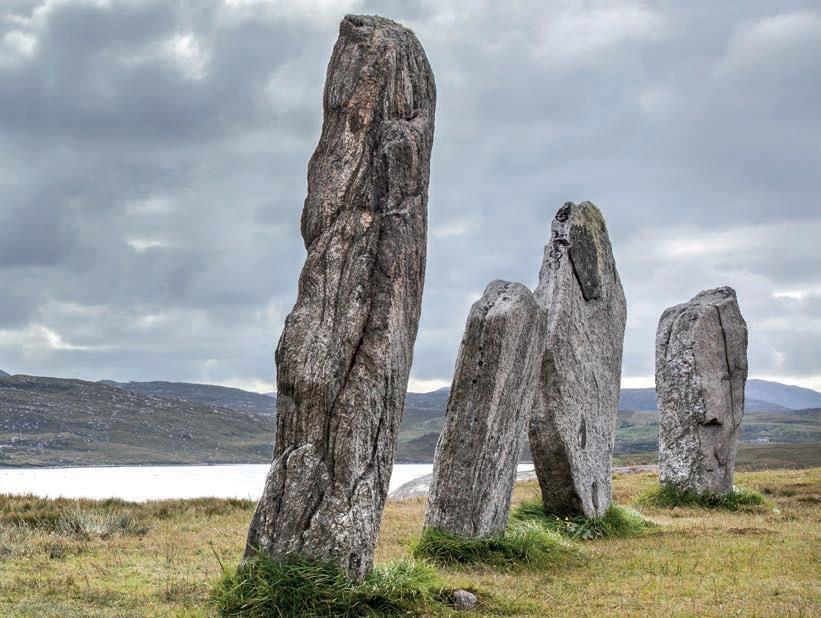
3 minute read
CONTENTS
STILL STANDING
4 The Guide to Scotland’s Islands A visit to any of the standing stones, circles and brochs of the Hebrides and west coast will deepen your understanding of, and respect for, those who built their lives on the fringes of the Atlantic millennia before us, as Ailsa Sheldon finds
In a world of instant online answers, there is something wonderful about historical mysteries that offer, as yet, no definitive explanation. One of the pleasures of visiting the Hebrides and the west coast is the chance to immerse yourself in a remote, windswept landscape and wonder about those who lived here thousands of years ago. Calanais (also often spelled as Callanish) may be the best known, but there's a wealth of fascinating archaeological sites that tell the story of ancient Scotland across the west coast and islands.
Standing stones are the oldest monuments in Scotland, with sites found on Arran, Islay, Jura, Mull, Coll, Barra, Harris and, most prominently, Lewis. The Calanais standing stones (pictured) predate Stonehenge and are at least 5000 years old. These slabs of Lewisian gneiss are arranged in a cross shape with a circle at the centre, and there is evidence of 2000 years of ritual use. Near Calanais, there are other smaller standing stones and stone circles from the same era that attract fewer visitors, some signposted from the road. To visit Calanais without the crowds, get there first thing in the morning, or after 3pm when the tour buses leave.
Theories abound on the purpose of standing stones. Many experts suggest they were astrological observatories used to track the movements of the sun and the stars, perhaps for ritual or religious purposes. We know that some marked burial chambers. Like all good mysteries, with more answers come more questions and there is much still to know about these Neolithic megaliths.
Brochs are unique to Scotland and are among the most advanced Iron Age constructions in Europe. Windowless dry-stone buildings in a tall ‘cooling tower’ shape, they feature stone steps spiralling between concentric inner and outer walls that provide access to upper floors, with smaller rooms entered from the central area. Archaeologists believe brochs had wooden floors and conical thatched roofs. We don’t know for sure what purpose brochs served, and usage may have changed over time depending on local politics – perhaps for refuge in tumultuous periods and storage in peacetime.
There is also much to suggest brochs played an important role in asserting status. Pottery fragments found in brochs show evidence of imported Mediterranean wines and olives (predating Romans in Britain) which gives a useful indication to the wealth of broch owners.
Scotland has over 500 known brochs, with the Broch of Mousa on Shetland the best-preserved example, still standing at 13.3 metres and the tallest prehistoric building in the UK. However, the west of Scotland is home to many important examples. The Glenelg brochs Dun Telve and Dun Troddan were constructed between 2000 and 2500 years ago in beautiful Gleann Beag near Kyle of Lochalsh. Built unusually close together, these two brochs retain many distinctive architectural features and much of their original walls. Over the water, the hilltop location of Dun Beag on Skye suggests it was used for defence, and the strong walls show the skill of these early builders. Medieval coins discovered at Dun Beag invite questions about how long this structure was used for. Dun Carloway on Lewis still stands close to its original height at around 9m tall, and shows signs of differing use over time, including as a stronghold in the 1500s and allegedly as a home in the 1870s.
Standing stones and brochs are our most prominent ancient monuments but there are many more interesting structures to discover across the region, including cairns, souterrains, Iron Age forts and crannogs. Neolithic and Bronze Age cairns (not to be confused with mountain cairns) are found all over Scotland and were used to bury high status individuals. The Nether Largie Cairns at Kilmartin, south of Oban, are a very well-preserved example.
And they're probably not alone. Many of our archaeological treasures were once buried in peat, which played an important role in preserving these ancient structures. It is highly likely that, hidden just below the surface, there are still many more of Scotland’s stories to discover.

Historic Environment Scotland cares for many of Scotland’s historic sites. Visit historicenvironment.scot to learn more about the places mentioned here and many more, including directions to nd them.










